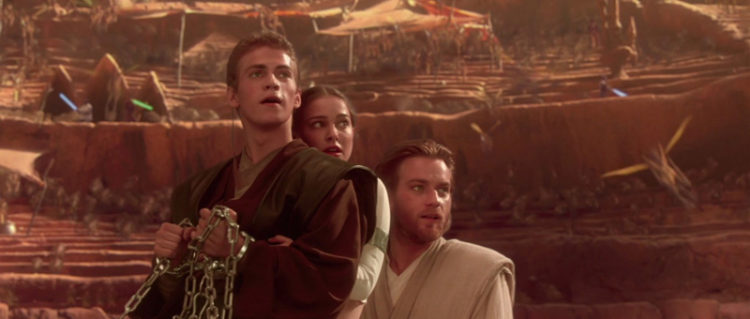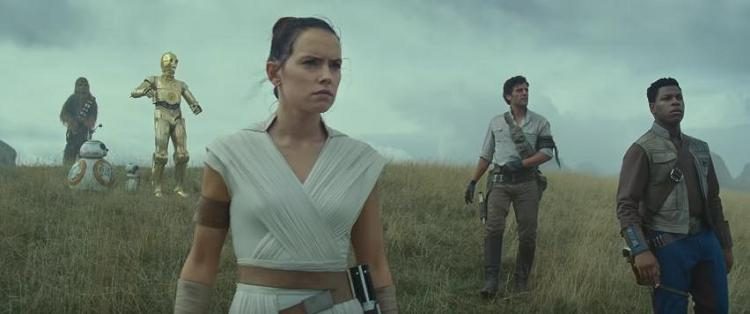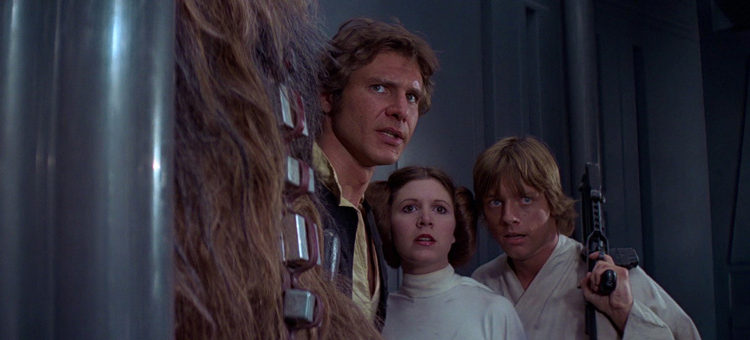Thirty-six years ago, a movie cut from the image of its protagonists—together again, alive, smiling, and dancing—under the wavering torchlight of hundreds of bonfires and surrounded by the celebratory revel of a hundred sentient bear-creatures to a shout of familiar end credits music and blue lettering.
And, with that, the Star Wars movies were over.
Done.
There was never going to be another Star Wars movie again. The heroes had suffered but had triumphed. It seemed that good had conquered and even converted evil. Two characters were in love and another had found his place in the universe. Nobody was dead except the bad guys, and even then, one of them had redeemed himself in the process. The audience was satisfied and dissatisfied in equal measure. Everything was as it should be.
We had attained as close to a happily-ever-after as we, and the characters, could hope for.
Thirty-six years and five more saga films later, that’s not the case.
The fan reaction to the sequel trilogy has been, ahem, uh, mixed. If you’re reading this, you’re probably well aware of the complaints about The Force Awakens (mostly, about what people asserted was its derivative nature) and The Last Jedi (I can’t list them all). At worst, TFA was labeled as a soulless facsimile of A New Hope and TLJ as the literal anti-Star Wars in a biblical mode. There was and is a boiling outrage about the films and, at the core of that, frustration with how they’ve been handled.
War continues to rage across the Galaxy Far, Far Away in all its familiar iconography. Those same beloved characters have died, failed, or are now alone as their direct and spiritual progeny fight it out across single-biosphere planets and unimaginably-sized starships. It seems as if good did not conquer evil. The light did not wash away the dark. The bright future so many moviegoers (if maybe not Legends readers) had imagined for Luke Skywalker, Princess Leia, Han Solo and the rest was not to be. There was a sentiment that nothing that had taken place in the original trilogy mattered. That the hard-fought-for ending was all for nothing. There was no happily ever after after all.
And that’s actually okay. Not only okay, but in some ways maybe it’s even better.
The original Star Wars trilogy is often considered to be a prime example of the Hero’s Journey. It’s a narrative archetype that we use to define hundreds of our stories from Beowulf to Harry Potter and, if you’re reading this, you probably know all the Campbellian basics. The Star Wars sequel trilogy, though, is a step beyond that. Not only does it seek to tell its own hero’s journey with a new cast of characters of its own, but it also seeks to recontextualize the entire saga. The upcoming The Rise of Skywalker isn’t said to be just an ending for this story, but for everything. It’s the end to the end to the end we thought we already had, building on, standing over, tying up, expanding, redefining what came before.
In continuing to tell the story, it’s almost like, maybe unintentionally, the people behind the sequel trilogy are creating something beyond the heroic journey. It’s becoming a heroic cycle. It’s no longer about just one hero, but many heroes across several generations, cataloging the cyclical nature of good and evil, of love and loss, of space peace and space war.

It’s something that started with the prequel trilogy. Simply by continuing the story at all, George Lucas added a new layer, a new narrative, and a new hero (well, relatively) to the journey. Except, with the prequels, it’s the inverse. The prequels are a deconstruction of that journey. Prequels, all prequels (not just Star Warsian ones), are inherently fatalistic. They connect narrative lines as if on a numerically-labeled grid. We read the plot of a prequel with the grim expression of a fortune-teller reading palms. We know where it ends. Star Wars was beginning to become more than its Campbellian base, but in moving backward, it was harder to see.
Then came the sequels.
Unlike the prequels, the sequels, simply by existing, had to take the original trilogy and drag it kicking and screaming into the future.
That comes at a narrative, and possibly disappointing, price. Stories have a beginning, middle, and end, and by their very nature condition us to believe wholeheartedly in that structure. The hero is pitted against the central conflict of their life, surmounts that conflict, and is usually rewarded in some way. When you stretch out a story, say, along a nine-movie, forty-two-year period, you begin to realize that the central conflict wasn’t the central conflict. It’s one among many. The rewards begin to feel less so because they are temporary—and because we see ourselves in the stories we love, that can be disappointing.
This can explain some of the adverse reaction to certain decisions made in the sequel trilogy. We live our lives believing that if we do the right things at the right times, that if we are good and whole and brave and true, we too can be happy eternally. That’s why we love a happy ending so much. It means that maybe there’ll be one for us too. But when you have to watch your heroes suffer, fail, and learn anew, it gets sad. It gets sad because it’s a little closer to aspects of our own lives than some of us may like in our space fantasy.

In one sense, the sequel trilogy, in unveiling the thematic scale of the Star Wars saga, tells us a hard truth: everything is temporary. Joy, happiness, love, pain, loss, despair, anger, love, hate. These are temporary things. Peace is temporary. War is temporary. The things that we fight so hard for don’t always stay the way we want them. It’s up to us to keep up the fight. Our legacy, just like those in a Galaxy Far, Far Away, is a never-ending battle with the good and evil both in our world and inside ourselves.
I know in one way that sounds sad. The idea of a never-ending battle with reemerging evil sounds exhausting, but it also means that there is always going to be a reemerging good to meet it. There is always going to be someone there to give us hope, to remind us why fighting for good is worth it, even if it only lasts a little while. It’s not worth it because it is forever, it’s worth it because it’s rare, because it’s finite, and that makes it beautiful.
In moving the story forward, in the transmutation from the Hero’s Journey into the hero’s cycle, Star Wars has given us, in all its bombastic laser-sword-fighting majesty, something a little closer to the cycle of our own lives. We look across the campus of history and we see the hero’s cycle replayed in our own world. We’ve seen the same evil rise over and over and the same good rise time and again to meet it. We’ve failed and we’ve succeeded and we will fail and succeed again.
And, somehow, this makes the Star Wars saga even bigger than we imagined and its roots in us and who we are much deeper. There’s something special about the most bankable franchise on Earth, intentionally or unintentionally, telling that story. There’s something miraculous about looking into the mirror and seeing our lives reflected in the stars.


thank you.
I was trying to write something to this effect a few weeks ago after seeing some criticism to Endgame. You did such a better job than I would have. Thank you, this is what every Star Wars fan needs to read.
Thank you. It’s so nice to hear this. I hope you get your article out anyway. It’s a thought worth analyzing through different lenses.